
I am passionate about various deep learning techniques for data inferences and reasoning. I have extensively worked on developing HPC empowered ML algorithms for mining big data. My current works are on distributed Matrix and Tensor factorization. I am also interested in accelerating deep learning frameworks with Tensor factorization.
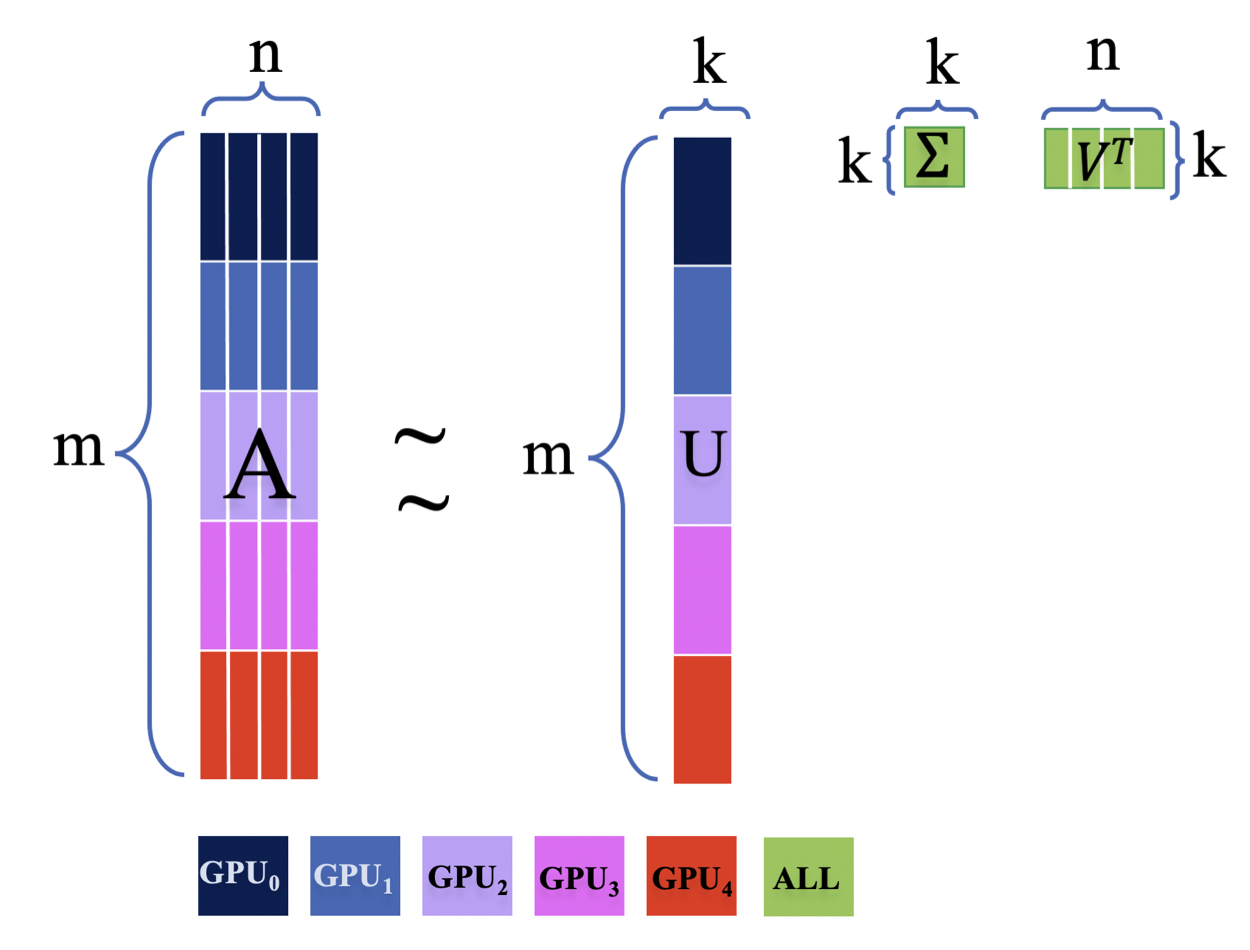
We propose an efficient, distributed, out-of-memory implementation of the truncated singular value decomposition (t-SVD) for heterogeneous (CPU+GPU) high performance computing (HPC) systems. Various implementations of SVD have been proposed, but most only estimate the singular values as an estimation of the singular vectors which can significantly increase the time and memory complexity of the algorithm. In this work, we propose an implementation of SVD based on the power method, which is a truncated singular values and singular vectors estimation method. Memory utilization bottlenecks seen in the power method are typically associated with the computation of the Gram matrix $\mat{A}^T\mat{A}$, which can be significant when $\mat{A}$ is large and dense, or when $\mat{A}$ is super-large and sparse. The proposed implementation is optimized for out-of-memory problems where the memory required to factorize a given matrix is greater than the available GPU memory. We reduce the memory complexity of $\mat{A}^T\mat{A}$ by using a batching strategy where the intermediate factors are computed block by block. We also suppress I/O latency associated with both host-to-device (H2D) and device-to-host (D2H) batch copies by overlapping each batch copy with compute using CUDA streams. Furthermore, we use optimized \textit{NCCL} based communicators to reduce the latency associated with collective communications (both intra-node and inter-node). In addition, sparse and dense matrix multiplications are significantly accelerated with GPU cores (or tensors cores when available), resulting in an implementation with good scaling. We demonstrate the scalability of our distributed out of core SVD algorithm to successfully decompose dense matrix of size 1TB and sparse matrix of size 128PB with 1e-6 sparsity.

Active transcription is initiated and assisted by transcription factors (TF) binding to DNA, a process influenced by various epigenomic mechanisms. Local biophysical properties of DNA, such as local thermodynamic stability, shape, and flexibility, are important for TF-DNA binding. The structural stability of DNA is primarily governed by hydrogen bonds. Because hydrogen bonds are much weaker than covalent bonds, DNA at physiological temperature experiences conformational motions resulting from inherent thermal fluctuations. Such thermal motions of double-stranded DNA spontaneously induce local opening and closing of the double helix, i.e., “DNA breathing dynamics” or “DNA bubbles” and their propensities are interrelated with DNA local flexibility. The effects of DNA breathing features, such as base-pair flipping propensity and typical bubble length and height on TF binding and gene expression have been shown by multiple studies. DNA shape (i.e., the local 3D structure of the double helix) is also important for TF binding. Many TFs not only recognize DNA sequence but also local DNA shape features, such as DNA binding and minor groove width. Many of the breathing and shape features can be influenced by nucleotides outside the TF motif, which has the potential to shed light on mechanisms of functional noncoding variants associated with disease risk, found in numerous genome-wide association studies. In this work, we integrate biophysical properties of DNA, derived in a high-throughput manner with DNA sequence into the modeling of TF binding specificity in a deep attention DNA machine learning model (DADm). We trained our DADm on TF binding specificity using protein binding microarray data for 203 mammalian TFs. We demonstrate that DADm, based only on DNA sequence, outperforms other state-of-the-art methods. Further, we encode in DADm DNA breathing dynamics and shape together with the sequence. Thus, DADm convolution layer captures the sequence along with DNA biophysical characteristics, the attention layer captures their significant importance and the recurrent layer captures long-term dependencies between the sequence and physicochemical characteristics to learn a new regulatory 'grammar' and improve DADm’s predictions. Our results show that DNA breathing and shape characteristics-augmented models compared favorably to sequence-based models, which we also verified with attention maps of the trained model.

With the boom in the development of computer hardware and software, social media, IoT platforms, and communications, there has been an exponential growth in the volume of data produced around the world. Among these data, relational datasets are growing in popularity as they provide unique insights regarding the evolution of communities and their interactions. Relational datasets are naturally non-negative, sparse, and extra-large. Relational data usually contain triples, (subject, relation, object), and are represented as graphs/multigraphs, called knowledge graphs, which need to be embedded into a low-dimensional dense vector space. Among various embedding models, RESCAL allows learning of relational data to extract the posterior distributions over the latent variables and to make predictions of missing relations. However, RESCAL is computationally demanding and requires a fast and distributed implementation to analyze extra-large real-world datasets. Here we introduce a distributed non-negative RESCAL algorithm for heterogeneous CPU/GPU architectures with automatic selection of the number of latent communities (model selection), called pyDRESCALk. We demonstrate the correctness of pyDRESCALk with real-world and large synthetic tensors, and the efficacy showing near-linear scaling that concurs with the theoretical complexities. Finally, pyDRESCALk determines the number of latent communities in an 11-terabyte dense and 9-exabyte sparse synthetic tensor
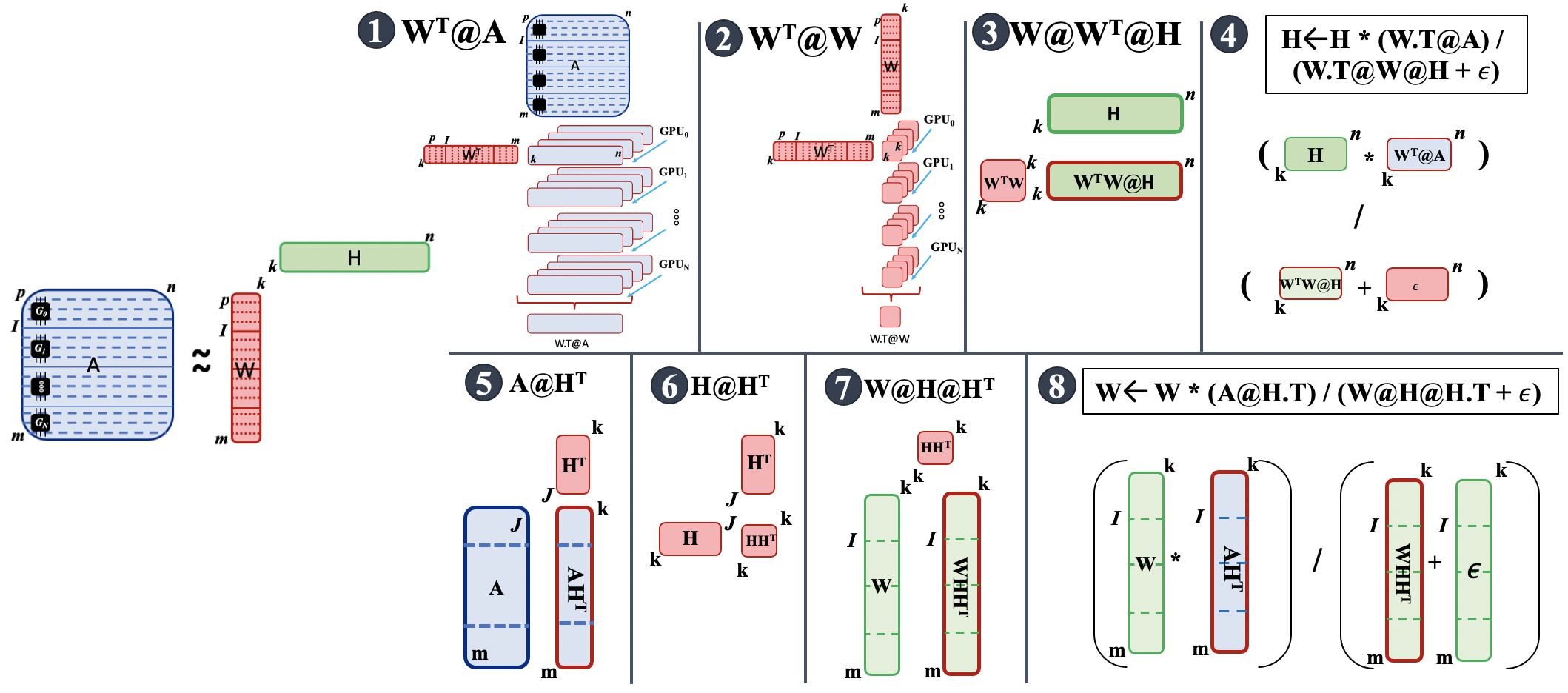
The need for efficient and scalable big-data analytics methods is more essential than ever due to the exploding size and complexity of globally emerging datasets. Nonnegative Matrix Factorization (NMF) is a well-known explainable unsupervised learning method for dimensionality reduction, latent feature extraction, blind source separation, data mining, and machine learning. In this paper, we introduce a new distributed out-of-memory NMF method, named pyDNMF-GPU, designed for modern heterogeneous CPU/GPU architectures that is capable of factoring exascale-sized dense and sparse matrices. Our method reduces the latency associated with local data transfer between the GPU and host using CUDA streams, and reduces the latency associated with collective communications (both intra-node and inter-node) via NCCL primitives. In addition, sparse and dense matrix multiplications are significantly accelerated with GPU cores, resulting in good scalability. We set new benchmarks for the size of the data being analyzed: in experiments, we measure up to 76x improvement on a single GPU over running on a single 18 core CPU and we show good weak scaling on up to 4096 multi-GPU cluster nodes with approximately 25,000 GPUs, when decomposing a dense 340 Terabyte-size matrix and a 11 Exabyte-size sparse matrix of density 10e-6. Finally, we integrate our method with an automatic model selection method. With this integration, we introduce a new tool that is capable of analyzing, compressing, and discovering explainable latent structures in extremely large sparse and dense data.
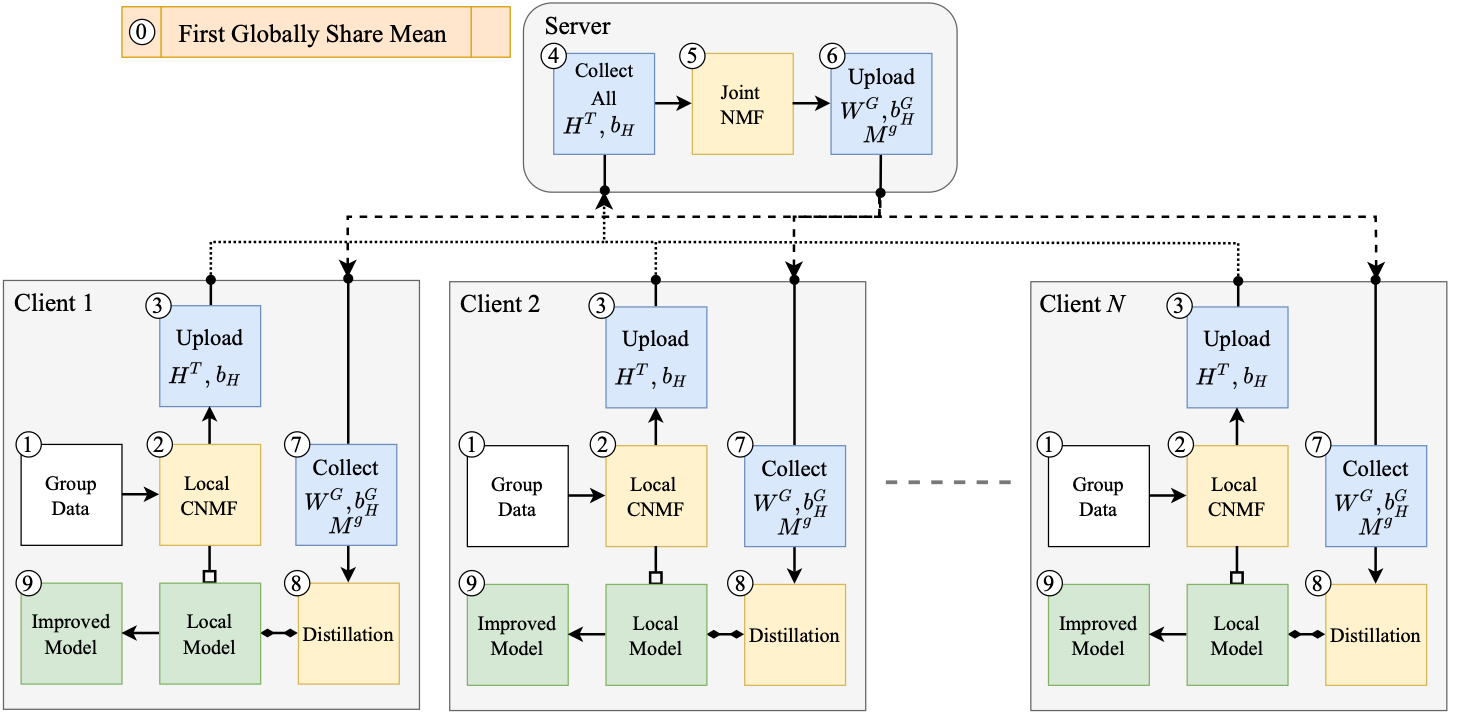
Non-negative matrix factorization (NMF) with missing-value completion is a well-known effective Collaborative Filtering (CF) method used to provide personalized user recommendations. However, traditional CF relies on the privacy-invasive collection of users' explicit and implicit feedback to build a central recommender model. One-shot federated learning has recently emerged as a method to mitigate the privacy problem while addressing the traditional communication bottleneck of federated learning. In this paper, we present the first unsupervised one-shot federated CF implementation, named FedSPLIT, based on NMF joint factorization. In our solution, the clients first apply local CF in-parallel to build distinct client-specific recommenders. Then, the privacy-preserving local item patterns and biases from each client are shared with the processor to perform joint factorization in order to extract the global item patterns. Extracted patterns are then aggregated to each client to build the local models via knowledge distillation. In our experiments, we demonstrate the feasibility of our approach with standard recommendation datasets. FedSPLIT can obtain similar results than the state of the art (and even outperform it in certain situations) with a substantial decrease in the number of communications.
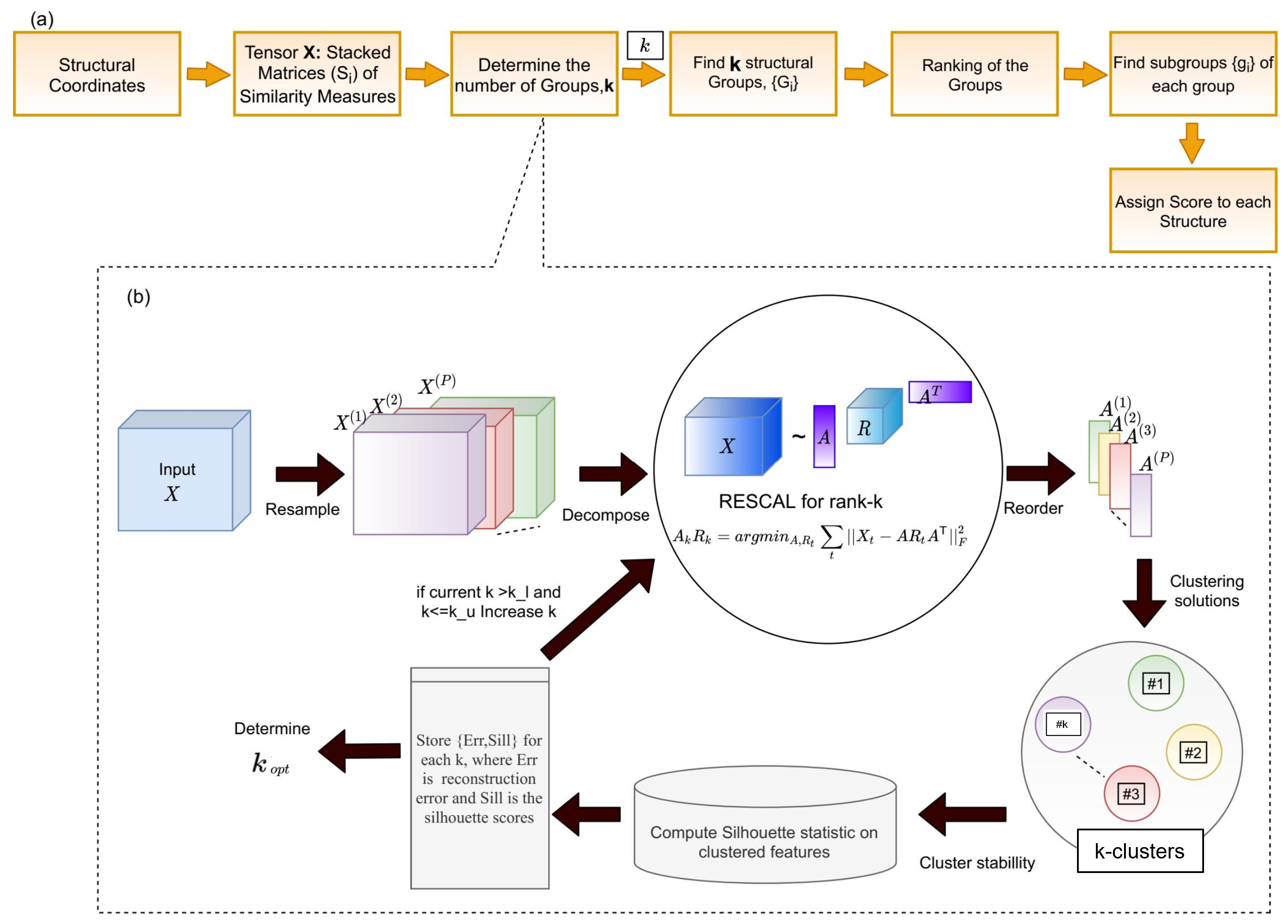
Finding the inherent organization in the structure space of a protein molecule is central in many computational studies of proteins. Grouping or clustering tertiary structures of a protein has been leveraged to build representations of the structure-energy landscape, highlight stable and semi-stable structural states, support models of structural dynamics, and connect them to biological function. Over the years, our laboratory has introduced methods to reveal structural states and build models of state-to-state protein dynamics. These methods have also been shown competitive for an orthogonal problem known as model selection, where model refers to a computed tertiary structure. Building on this work, in this paper we present a novel, tensor factorization-based method that doubles as a non-parametric clustering method. While the method has broad applicability, here we focus and demonstrate its e cacy on the estimation of model accuracy (EMA) problem. The method outperforms state-of-the-art methods, including single-model methods that leverage deep neural networks and domain-specific insight.
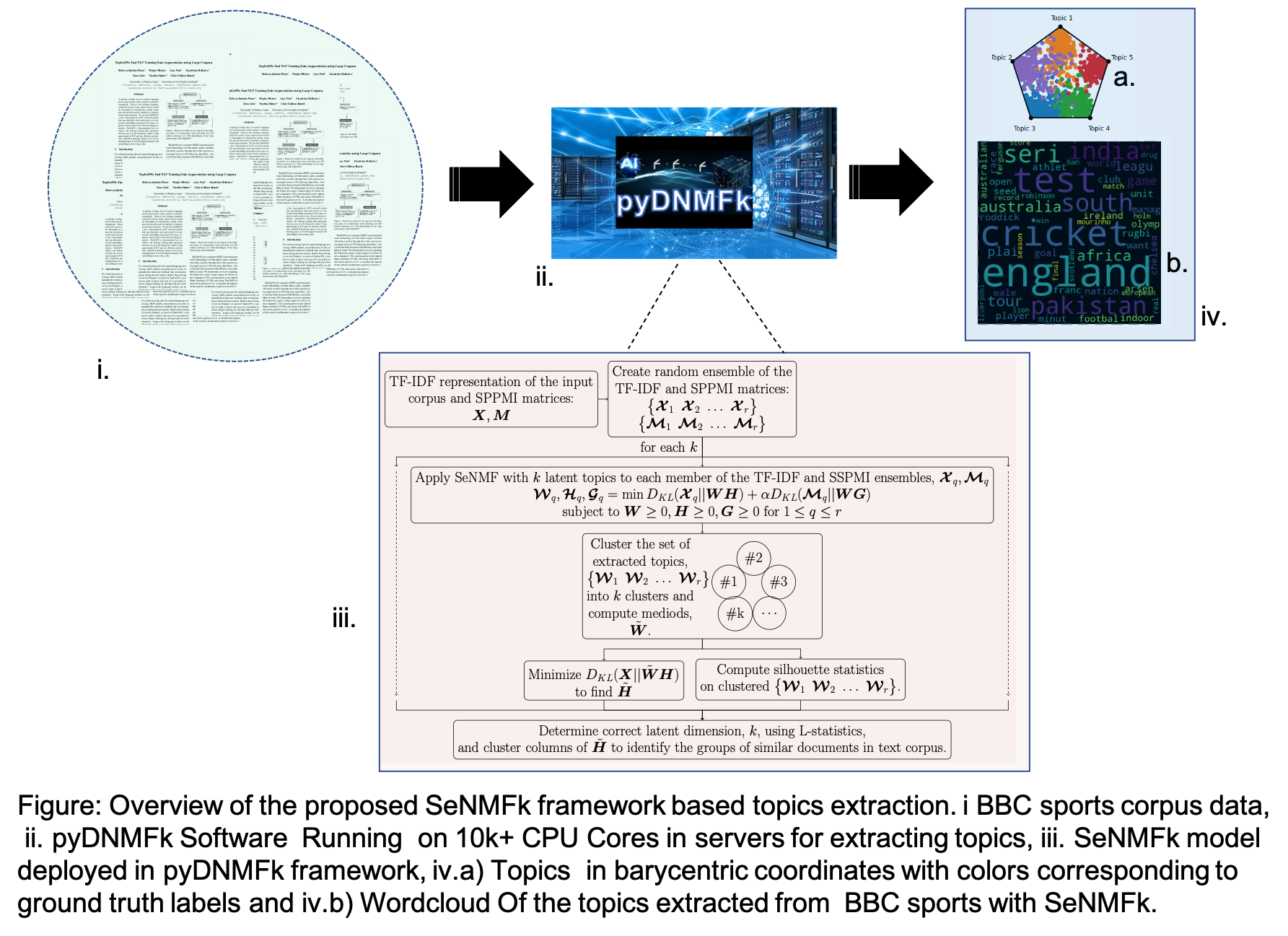
Topic modeling, or identifying the set of \textit{topics} that occur in a collection of articles, is one of the primary objectives of text mining. One of the big challenges in topic modeling is determining the correct number of topics: underestimating the number of topics results in a loss of information, i.e., omission of topics, underfitting, while overestimating leads to noisy and unexplainable topics and overfitting. In this paper, we consider a semantic-assisted non-negative matrix factorization (NMF) topics model, which we call SeNMFk, based on Kullback-Leibler(KL) divergence and integrated with a method for determining the number of latent topics. SeNMFk involves (i) creating a random ensemble of pairs of matrices whose mean is equal to the initial words-by-documents matrix representing the text corpus and the Shifted Positive Pointwise Mutual Information (SPPMI) matrix, which encodes the context information, respectively, and (ii) jointly factorizing each of these pairs with different number of topics to acquire sets of latent topics that are stable to noise. We demonstrate the performance of our method by identifying the number of topics in several benchmark text corpora, when compared to other state-of-the-art techniques. We also show that the number of document classes in the input text corpus may differ from the number of the extracted latent topics, but these classes can be retrieved by clustering the column-vectors of one of the factor matrices. Additionally, we introduce a software called pyDNMFk to estimate the number of topics. We demonstrate that our unsupervised method, SeNMFk, not only determines the correct number of topics, but also extracts topics with a high coherence and accurately classifies the documents of the corpus.
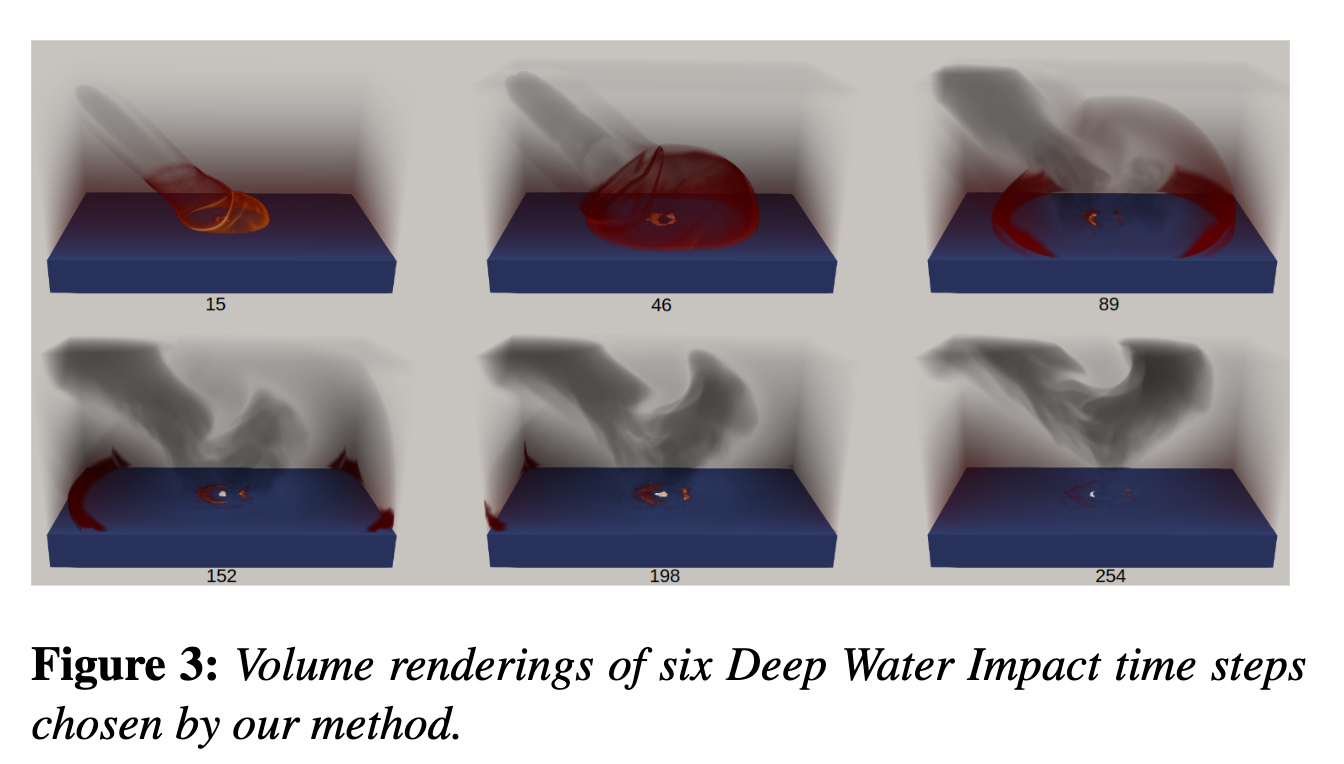
Choosing salient time steps from spatio-temporal data is useful for summarizing the sequence and developing visualizations for animations prior to committing time and resources to their production on an entire time series. Animations can be developed more quickly with visualization choices that work best for a small set of the important salient timesteps. Here we introduce a new unsupervised learning method for finding such salient timesteps. The volumetric data is represented by a 4-dimensional non-negative tensor, X(t; x; y; z).The presence of latent (not directly observable) structure in this tensor allows a unique representation and compression of the data. To extract the latent time-features we utilize non-negative Tucker tensor decomposition. We then map these time-features to their maximal values to identify the salient time steps. We demonstrate that this choice of time steps allows a good representation of the time series as a whole.
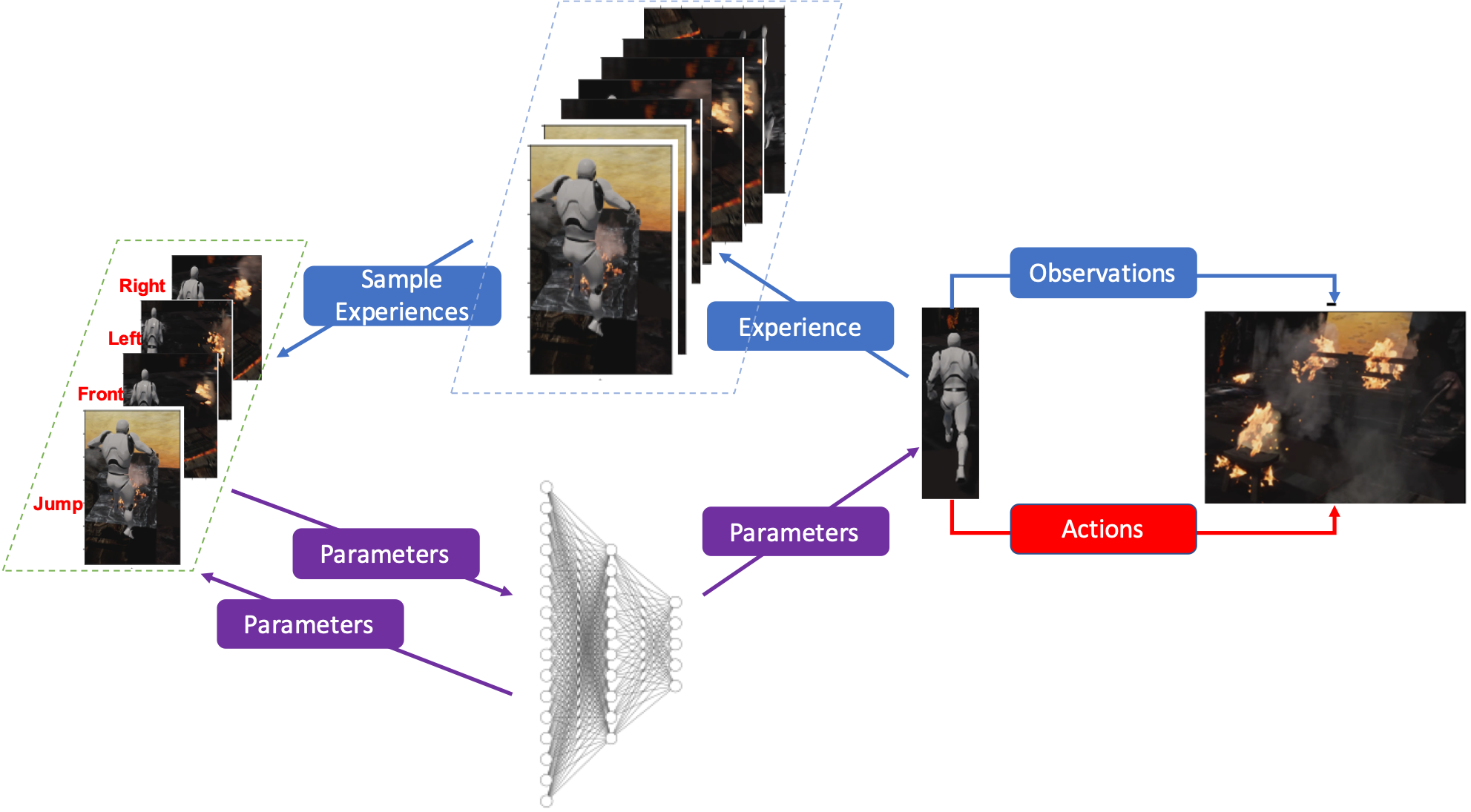
Live fire creates a dynamic, rapidly changing environment that presents a worthy challenge for deep learning and artificial intelligence methodologies to assist firefighters with scene comprehension in maintaining their situational awareness, tracking and relay of important features necessary for key decisions as they tackle these catastrophic events. We propose a deep Q-learning based agent who is immune to stress induced disorientation and anxiety and thus able to make clear decisions for navigation based on the observed and stored facts in live fire environments. As a proof of concept, we imitate structural fire in a gaming engine called Unreal Engine which enables the interaction of the agent with the environment. The agent is trained with a deep Q-learning algorithm based on a set of rewards and penalties as per its actions on the environment. We exploit experience replay to accelerate the learning process and augment the learning of the agent with human-derived experiences. The agent trained under this deep Q-learning approach outperforms agents trained through alternative path planning systems and demonstrates this methodology as a promising foundation on which to build a path planning navigation assistant capable of safely guiding fire fighters through live fire environments.
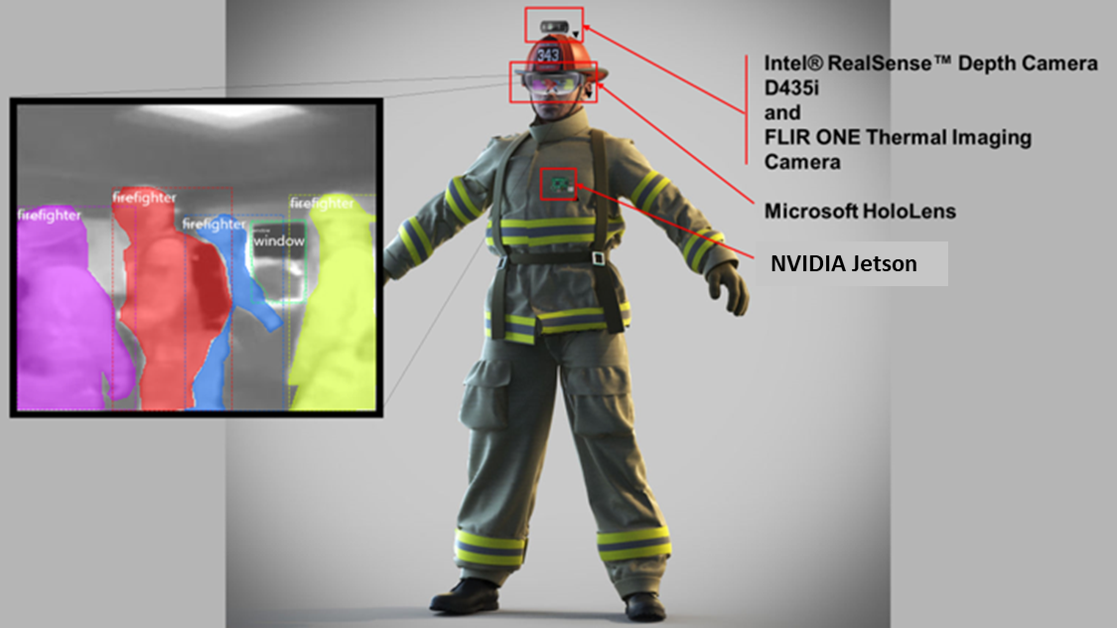
Firefighting is a dynamic activity, in which numerous operations occur simultaneously. Maintaining situational awareness (i.e., knowledge of current conditions and activities at the scene) is critical to the accurate decision-making necessary for the safe and successful navigation of a fire environment by firefighters. Conversely, the disorientation caused by hazards such as smoke and extreme heat can lead to injury or even fatality. This research implements recent advancements in technology such as deep learning, point cloud and thermal imaging, and augmented reality platforms to improve a firefighter's situational awareness and scene navigation through improved interpretation of that scene. We have designed and built a prototype embedded system that can leverage data streamed from cameras built into a firefighter's personal protective equipment (PPE) to capture thermal, RGB color, and depth imagery and then deploy already developed deep learning models to analyze the input data in real time. The embedded system analyzes and returns the processed images via wireless streaming, where they can be viewed remotely and relayed back to the firefighter using an augmented reality platform that visualizes the results of the analyzed inputs and draws the firefighter's attention to objects of interest, such as doors and windows otherwise invisible through smoke and flames.
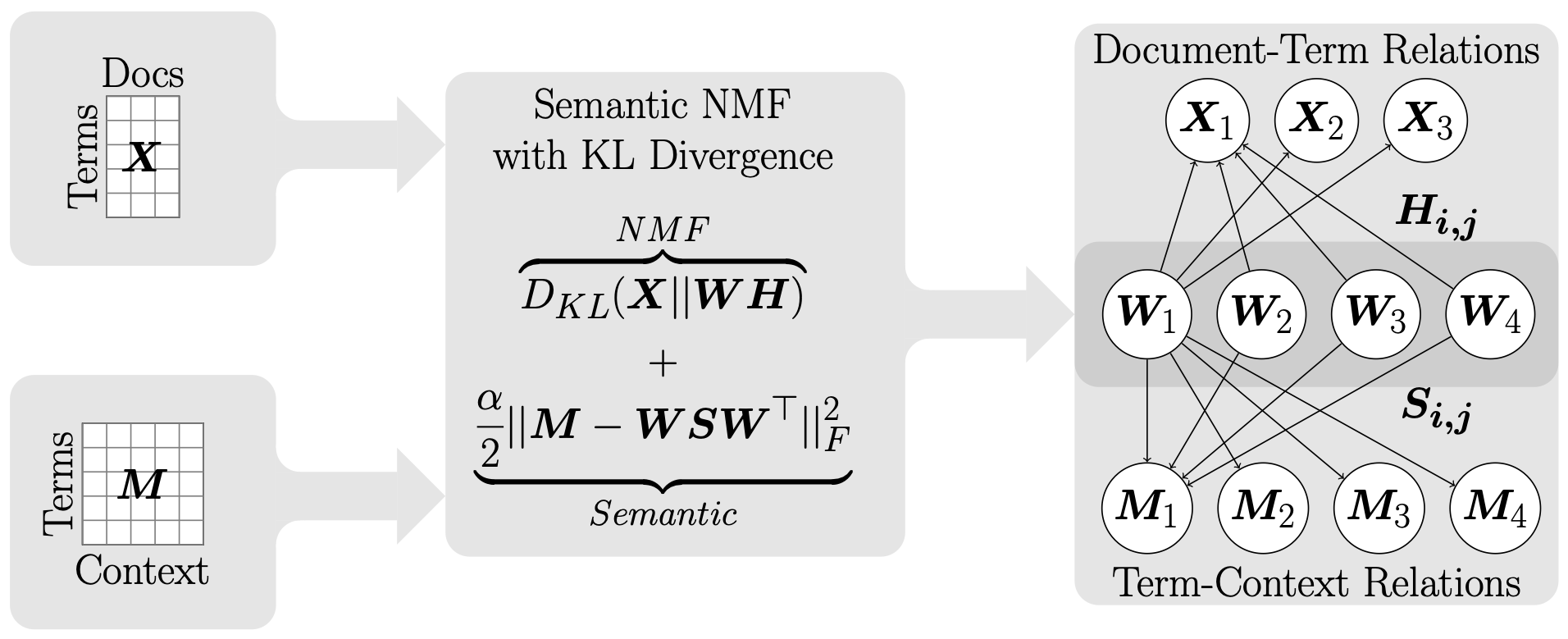
Non-negative Matrix Factorization (NMF) models the topics of a text corpus by decomposing the matrix of term frequency--inverse document frequency (TF-IDF) representation, X, into two low-rank non-negative matrices: W, representing the topics and H, mapping the documents onto space of topics. One challenge, common to all topic models, is the determination of the number of latent topics (aka model determination). Determining the correct number of topics is important: underestimating the number of topics results in a poor topic separation, under-fitting, while overestimating leads to noisy topics, over-fitting. Here, we introduce SeNMFk, a semantic-assisted NMF-based topic modeling method, which incorporates semantic correlations in NMF by using a word-context matrix, and employs a method for determination of the number of latent topics. SeNMFk first creates a random ensemble of matrices based on the initial TF-IDF matrix and a word-context matrix, and then applies a coupled factorization to acquire sets of stable coherent topics that are robust to noise. The latent dimension is determined based on the stability of these topics. We show that SeNMFk accurately determines the number of high-quality topics in benchmark text corpora, which leads to an accurate document clustering.
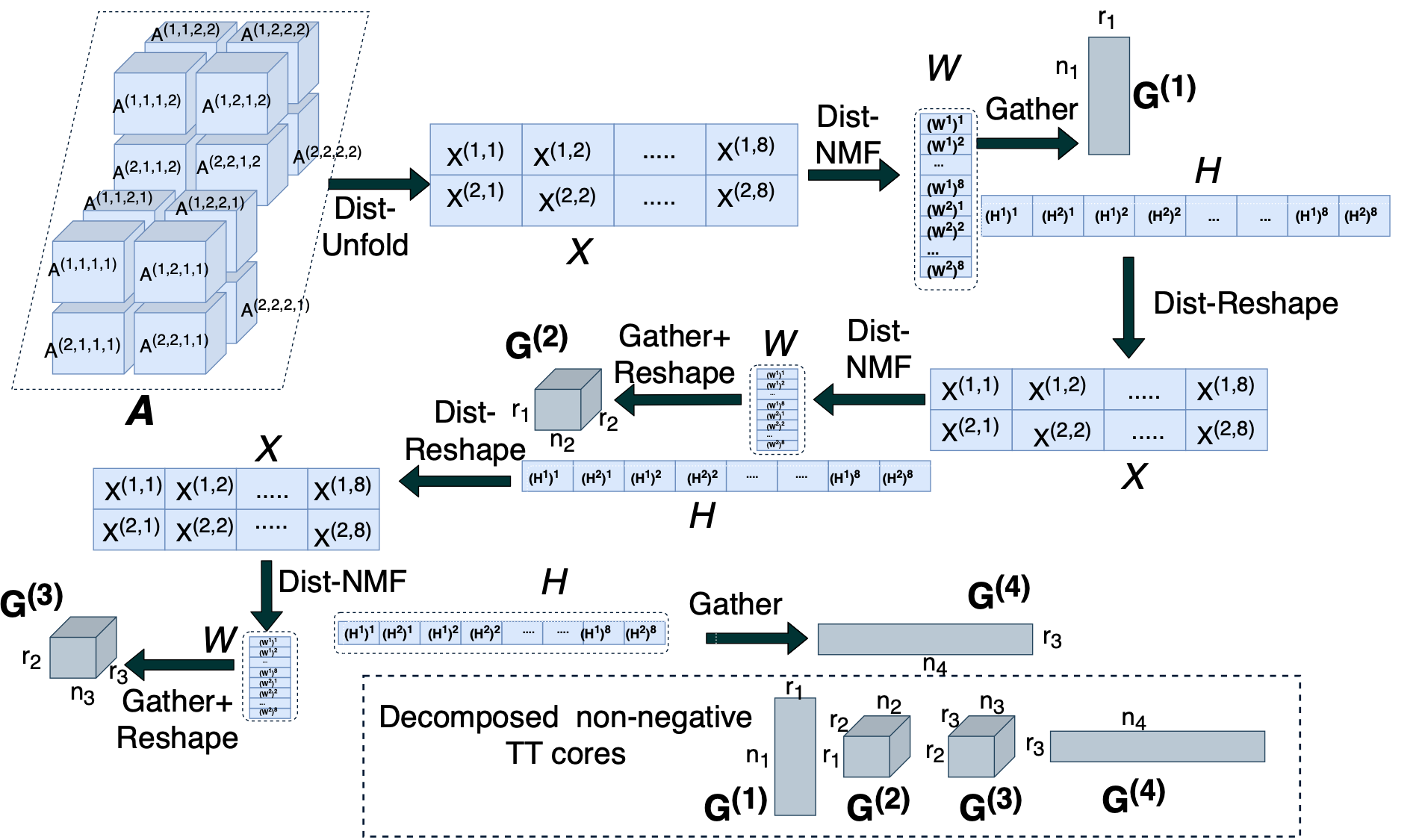
The era of exascale computing opens new venues for innovations and discoveries in many scientific, engineering, and commercial fields. However, with the exaflops also come the extra-large high-dimensional data generated by highperformance computing. High-dimensional data is presented as multidimensional arrays, aka tensors. The presence of latent (not directly observable) structures in the tensor allows a unique representation and compression of the data by classical tensor factorization techniques. However, the classical tensor methods are not always stable or they can be exponential in their memory requirements, which makes them not suitable for high-dimensional tensors. Tensor train (TT) is a state-of-the-art tensor network introduced for factorization of high-dimensional tensors. TT transforms the initial high-dimensional tensor in a network of three-dimensional tensors that requires only a linear storage. Many real-world data, such as, density, temperature, population, probability, etc., are non-negative and for an easy interpretation, the algorithms preserving non-negativity are preferred. Here, we introduce a distributed non-negative tensor-train and demonstrate its scalability and the compression on synthetic and realworld big datasets.
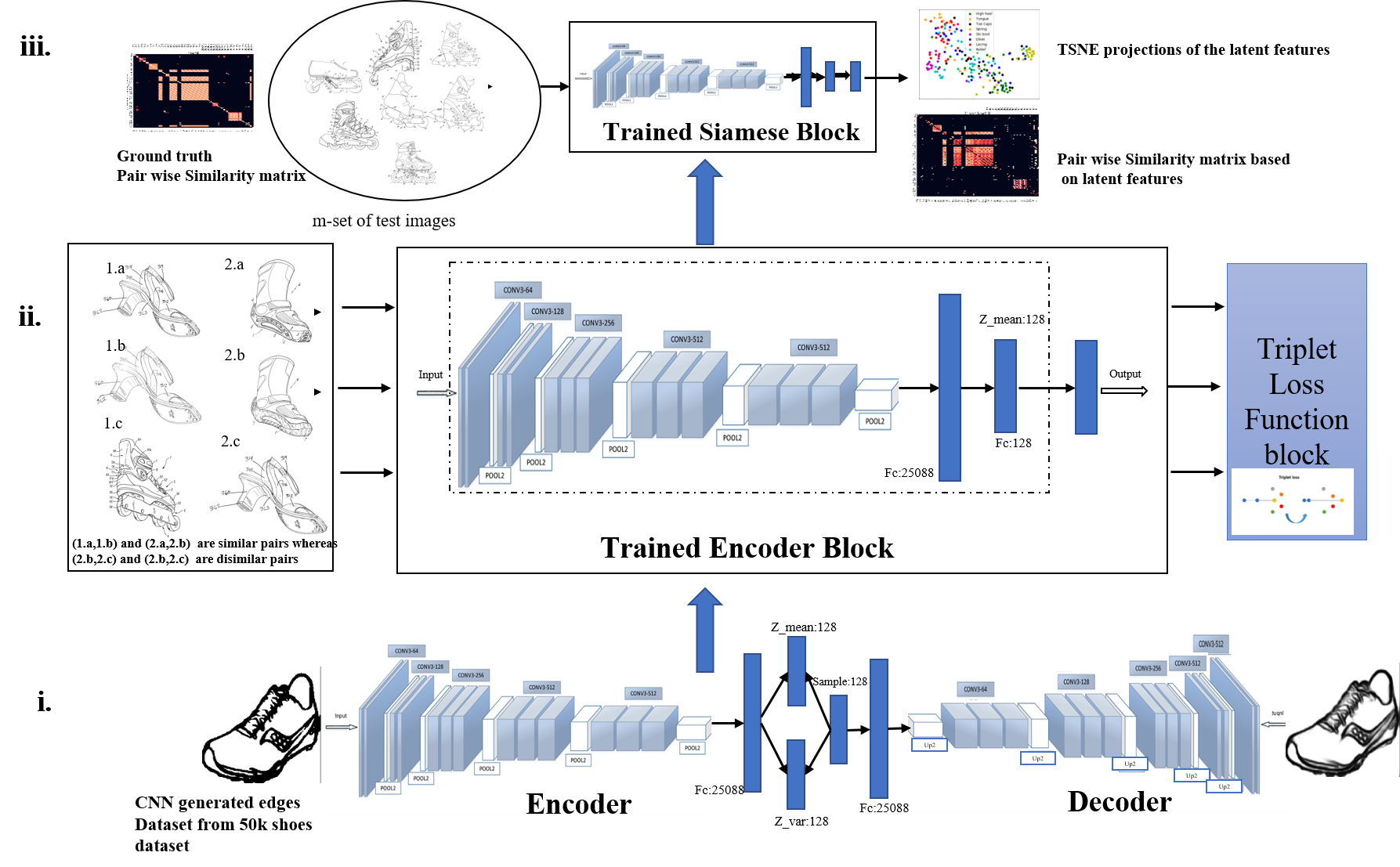
Resolution of the complex problem of image retrieval for diagram images has yet to be reached. Deep learning methods continue to excel in the fields of object detection and image classification applied to natural imagery. However, the application of such methodologies applied to binary imagery remains limited due to lack of crucial features such as textures, color and intensity information. This paper presents a deep learning based method for image-based search for binary patent images by taking advantage of existing large natural image repositories for image search and sketch-based methods.(Sketches are not identical to diagrams, but they do share some characteristics; for example, they both are gray scale (binary), composed of contours, and lacking in texture are key features for both imagery types.) We begin by using deep learning to generate sketches from natural images for image retrieval and then train a second deep learning model on the sketches. We then use our small set of manually labeled patent diagram images via transfer learning to adapt the image search from sketches of natural images to diagrams. Our experiment results show the effectiveness of deep learning with transfer learning for detecting near-identical copies in patent images and querying similar images based on content.

Binary image based classification and retrieval of documents of an intellectual nature is a very challenging problem. Variations in the binary image generation mechanisms which are subject to the document artisan designer including drawing style, view-point, inclusion of multiple image components are plausible causes for increasing the complexity of the problem. In this work, we propose a method suitable to binary images which bridges some of the successes of deep learning (DL) to alleviate the problems introduced by the aforementioned variations. The method consists on extracting the shape of interest from the binary image and applying a non-Euclidean geometric neural-net architecture to learn the local and global spatial relationships of the shape. Empirical results show that our method is in some sense invariant to the image generation mechanism variations and achieves results outperforming existing methods in a patent image dataset benchmark.

Intelligent detection and processing capabilities can be instrumental in improving the safety, efficiency, and successful completion of rescue missions conducted by firefighters in emergency first response settings. The objective of this research is to create an automated system that is capable of real-time, intelligent object detection and recognition and facilitates the improved situational awareness of firefighters during an emergency response. We have explored state-of-the-art machine/deep learning techniques to achieve this objective. The goal of this work is to enhance the situational awareness of firefighters by effectively exploiting the infrared video that is actively recorded by firefighters on the scene. To accomplish this, we use a trained deep Convolutional Neural Network (CNN) system to classify and identify objects of interest from thermal imagery in real-time. In the midst of those critical circumstances created by a structure fire, this system is able to accurately inform the decision-making process of firefighters with up-to-date scene information by extracting, processing, and analyzing crucial information. Utilizing the new information produced by the framework, firefighters are able to make more informed inferences about the circumstances for their safe navigation through such hazardous and potentially catastrophic environments.

Background:The unparalleled performance of deep learning approaches in generic image processing has mo-tivated its extension to neuroimaging data. These approaches learn abstract neuroanatomical and functionalbrain alterations that could enable exceptional performance in classification of brain disorders, predicting dis-ease progression, and localizing brain abnormalities. New Method:This work investigates the suitability of a modified form of deep residual neural networks (ResNet)for studying neuroimaging data in the specific application of predicting progression from mild cognitive im-pairment (MCI) to Alzheimer’s disease (AD). Prediction was conductedfirst by training the deep models usingMCI individuals only, followed by a domain transfer learning version that additionally trained on AD andcontrols. We also demonstrate a network occlusion based method to localize abnormalities. Results:The implemented framework captured non-linear features that successfully predicted AD progressionand also conformed to the spectrum of various clinical scores. In a repeated cross-validated setup, the learntpredictive models showed highly similar peak activations that corresponded to previous AD reports.Comparison with existing methods:The implemented architecture achieved a significant performance improve-ment over the classical support vector machine and the stacked autoencoder frameworks (p< 0.005), nu-merically better than state-of-the-art performance using sMRI data alone (> 7% than the second-best performingmethod) and within 1% of the state-of-the-art performance considering learning using multiple neuroimagingmodalities as well. Conclusions:The explored frameworks reflected the high potential of deep learning architectures in learningsubtle predictive features and utility in critical applications such as predicting and understanding disease pro-gression

Situational awareness and Indoor location tracking for firefighters is one of the tasks with paramount importance in search and rescue operations. For Indoor Positioning systems (IPS), GPS is not the best possible solution. There are few other techniques like dead reckoning, Wifi and bluetooth based triangulation, Structure from Motion (SFM) based scene reconstruction for Indoor positioning system. However due to high temperatures, the rapidly changing environment of fires, and low parallax in the thermal images, these techniques are not suitable for relaying the necessary information in a fire fighting environment needed to increase situational awareness in real time. In fire fighting environments, thermal imaging cameras are used due to smoke and low visibility hence obtaining relative orientation from the vanishing point estimation is very difficult. The following technique that is the content of this research implements a novel optical flow based video compass for orientation estimation and fused IMU data based activity recognition for IPS. This technique helps first responders to go into unprepared, unknown environments and still maintain situational awareness like the orientation and, position of the victim fire fighters.
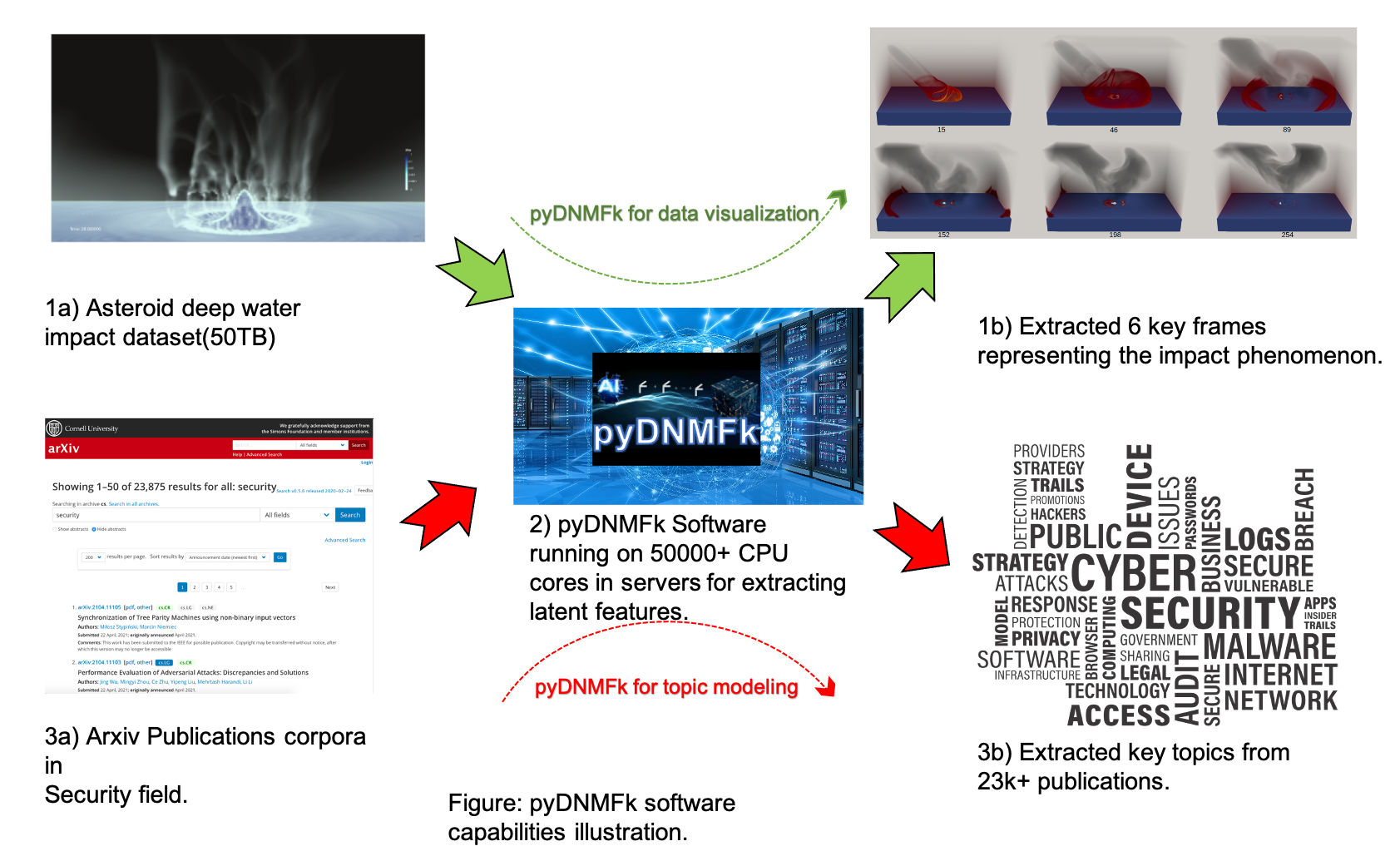
pyDNMFk is a software package for applying non-negative matrix factorization in a distributed fashion to large datasets. It can minimize the difference between reconstructed data and the original data through various norms (Frobenius, KL-divergence). Additionally, the Custom Clustering algorithm allows for automated determination for the number of Latent features. pyDNMFk Scales from laptops to clusters. The library is convenient on a laptop. It can be installed easily with conda or pip and extends the matrix decomposition from a single core to numerous cores across nodes. pyDNMFk is efficient and has been tested on powerful servers across LANL and Oakridge scaling beyond 1000+ nodes. This library facilitates the transition between single-machine to large scale cluster so as to enable users to both start simple and scale up when necessary.
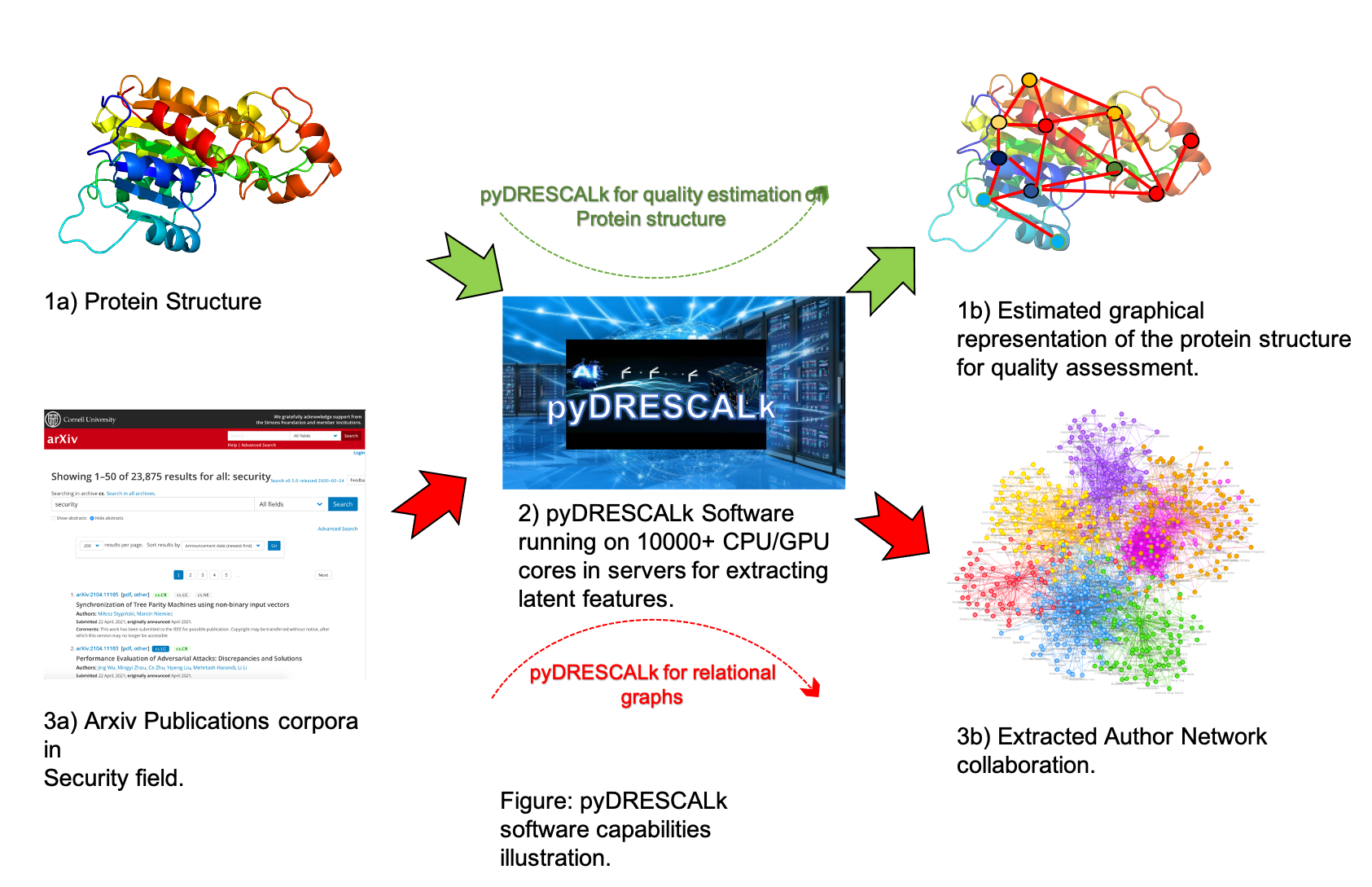
pyDRESCALk is a software package for applying non-negative RESCAL decomposition in a distributed fashion to large datasets. It can be utilized for decomposing relational datasets. It can minimize the difference between reconstructed data and the original data through Frobenius norm. Additionally, the Custom Clustering algorithm allows for automated determination for the number of Latent features.

pyDNTNK is a software package for applying non-negative Hierarchical Tensor decompositions such as Tensor train and Hierarchical Tucker decompositons in a distributed fashion to large datasets. It is built on top of pyDNMFk. Tensor train (TT) and Hierarchical Tucker(HT) are state-of-the-art tensor network introduced for factorization of high-dimensional tensors. These methods transform the initial high-dimensional tensor in a network of low dimensional tensors that requires only a linear storage. Many real-world data,such as, density, temperature, population, probability, etc., are non-negative and for an easy interpretation, the algorithms preserving non-negativity are preferred. Here, we introduce the distributed non-negative Hierarchical tensor decomposition tools and demonstrate their scalability and the compression on synthetic and real world big datasets.
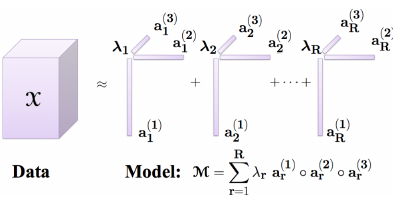
pyCP_APR is a Python library for tensor decomposition and anomaly detection. It is designed for the fast analysis of large datasets by accelerating computation speed using GPUs. pyCP_APR uses the CANDECOMP/PARAFAC Alternating Poisson Regression (CP-APR) tensor factorization algorithm utilizing both Numpy and PyTorch backend. While the Numpy backend can be used for the analysis of both sparse and dense tensors, PyTorch backend provides faster decomposition of large and sparse tensors on the GPU. pyCP_APR's Scikit-learn like API allows comfortable interaction with the library, and include the methods for anomaly detection via the p-values obtained from the CP-APR factorization. The anomaly detection methods via the p-values optained from CP-APR was introduced by Eren et al. using the Unified Host and Network Dataset.
I am really grateful to work with the following students.
| Name | Institution | Year | Topic |
|---|---|---|---|
| Maksim Eren | UMBC | 2021- | Tensor decomposition of Malware detection |
| Anuj Pokhrel | GMU | 2021 | Named Entity Recognition framework designn |
| Namita Kharat | CSU | 2021 | High performance Tensor decomposition tool design |
| Kazi Lutful Kabir | GMU | 2021 | Tensor decomposition for protein structures |
| William Zhao | UC Berkley | 2020 | Adversarial robustness of Matrix and Tensor decompositions |
| Aura Jensen-Curtis | UNM | 2019–2020 | Embedded deep learning system for firefighting applications |
| Hans Hofner | UNM | 2017 | Thermal Imaging object and human recognition |